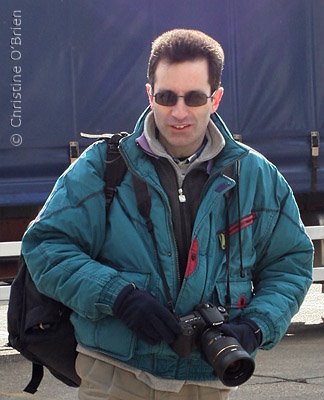Out, damned spot! - sensor dust (part 1)

Most people using DSLRs will at some time have to deal with sensor dust. I say "most", because an increasing number of cameras employ some sort of anti-dust mechanism. In fact I think it is likely that within a very few years sensor dust will be a non-issue on new cameras. Of course the dust isn't on the sensor at all, but on a piece of glass in front of the sensor. But how does the dust get there? The particles that you see will have come either from dust in the atmosphere, or may have come from inside the camera itself. It is not unknown for new cameras to shed a few particles as they loosen up after manufacture. Sometimes these particles are even a bit oily from the shutter mechanism. After some use this tends to settle down and most dust found is from the atmosphere outside the camera.
You can do things to reduce the amount of dust entering the camera. Keep the lens throat covered as much of the time as possible, either with a lens or with the body cap. When changing lenses keep the camera pointing down. Try not to change lenses more than necessary particularly in dry dusty environments. Don't pull your big zoom lenses in and out more than you need, particularly if they are the "push-pull" type, as they act like a bellows, pulling air (and dust) into the lens and the inside of the camera. Finally, always turn the camera off before changing lenses. The sensor gets warm when the camera is on, and this increases static build-up, which in turn attracts dust.
After you have used the camera for some time it is almost inevitable that there will be some dust on the sensor and this will need to be removed (unless you like using the healing brush in Photoshop). But you are not always aware of sensor dust. Some circumstances make it more or less visible on your images. I had very few problems with dust on any of my (Canon) SLRs until I got a 5D. There could be a number of reasons for this. It may be that the glass filter in front of the sensor is nearer to the sensor on the 5D, so bringing any pieces of dust into sharper focus. It may be that the bigger sensor retains more heat. There is a larger mirror in it so it will probably stir up the air inside the camera with greater vigour each time a shot is taken. When the camera was new some of the dust was obviously greasy and my first attempts left smears on the sensor. This seems more common with the full frame cameras. They have shutters which are designed for a longer harder life and are greased better. Some of the particles inside the camera had probably come from around the shutter mechanism.
Another factor is that if you tend to shoot with wide apertures you are less likely to see dust as it will not be rendered as sharp. If you want to check if dust is on your sensor just set the lens to it's smallest aperture and take a shot of a plain white surface (out of focus) overexposing about a stop or two. View the image on the computer and you will see what is on the sensor (increasing contrast in levels will make it look even more obvious, if you can stand the shock). Even after cleaning don't ever expect to see it looking perfect. If there is noticeably less dust and it is not visible in normal use that is as much as you can hope for.
There are essentially four methods of removing dust (the camera maker may employ other ones in the design of the camera). The first is to use a blower to try to blast the dust off the sensor. The second is to use a statically charged dry brush which is specially made for the purpose. The third is to remove pieces of dust with either a vacuum device or a sticky probe (sounds worse than it is). The forth is to use some sort of swab (either dry or wetted with a cleaning agent similar to isopropanol).
In the followup to this piece I will go into more detail about the ways of removing dust and also link to some information from other sources.
Picture: Denham snow 2007

0 Comments:
Post a Comment
<< Home